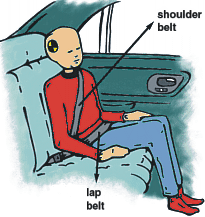|
Car Time
|
 |
In Stage 4, your child is over 36 kg (80 pounds), about 8 years of age,
and has grown enough to use the seat belt.
Did you know that children have been hurt or killed in a crash because
they were too small to use a seat belt? It is important that the seat
belt fits correctly. If you find that your child is too small for a seat
belt, use a booster seat or a forward-facing child seat that is right
for your child’s weight and height.
|
|
TP14340E
ISBN 0-662-30084-X
Cat. T46-29/2-2001E
Revised March 2006

|
|
|
Keep this in mind:
- The back seat is the safest place for your child.
- Seat belts with lap and shoulder straps will hold both the upper and lower body in place. They
provide the best protection for Stage 4 children riding in a vehicle.
- Slouching causes the lap belt to ride up over the stomach. Children whose legs can bend over the
edge of the seat when they are sitting up straight against the seat back are less likely to slouch.
Top
|
When to buckle up:
- Always follow vehicle instructions for using the seat belt.
- Check to be sure that children are not slouching in the seat.
- Keep the lap belt low and snug across the hips. Never put the lap belt across the stomach. This
could injure your child in a crash.
- Put the shoulder belt over the shoulder and across the chest. Never put the shoulder belt behind the child’s
back or under the arm. This could injure your child in a crash.
Top
|
|
Seat belts for adults:
- Seat belts help prevent deaths and they reduce the number of serious injuries in crashes. A seat belt helps
to spread the force of a crash over the strongest areas of the body. Parents should set a good example for
children by wearing their own seat belts correctly and using them all the time.
- To protect people in a crash, seat belts must be worn with the lap belt low across the hips and the shoulder
belt over the shoulder and across the chest.
- When worn correctly, the lap belt spreads the force of a crash over the bones in the hips and the shoulder
belt spreads the force of the crash across the chest.
Top
|
|
How to use the lap belt:
- Put the lap belt low across the hips and keep it snug.
- Never put the lap belt across the stomach. This could cause serious injuries because there
is no bone to absorb the force of the crash. In a crash, if you are not wearing a lap belt correctly,
you could suffer a broken spinal cord or serious damage to vital organs inside your body.
|

|
|
Top
|
|
How to use the shoulder belt:
- Put the shoulder belt over the shoulder and across the chest.
- Never put the shoulder belt under the arm. If a crash occurs, a shoulder belt under the arm could injure
your heart, lungs or other organs inside your body.
- If you have a choice between a lap seat belt and a lap/shoulder belt, remember that the
lap/shoulder belt will protect you better in a crash.
Top
|
Contact Us:
For questions about seat belts, please contact the manufacturer. For more information or to order more copies of this publication,
contact:
Transport Canada at:
1-800-333-0371, by email: roadsafetywebmail@tc.gc.ca
Health Canada at:
(613) 952-1014, by fax: (613) 941-4376 or by email: cps-spc@hc-sc.gc.ca
Top
You can also download "Car
Time - Stage 4: Safe Travel in a Seat Belt" (PDF format, 43Kb).
To view PDF documents you must use Adobe® Acrobat Reader. Visit the
Adobe site to download the latest, free version.
If you need an alternative format or for more information, please contact us by e-mail at
RoadSafetyWebMail@tc.gc.ca
or call toll free 1-800-333-0371 (Ottawa area (613) 998-8616).
|

